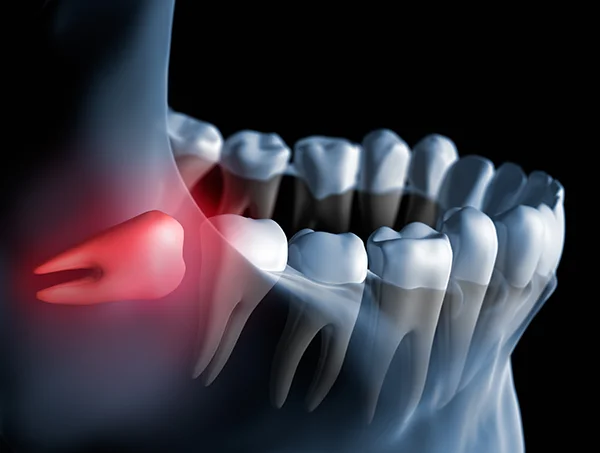Wisdom Teeth Removal Historically people had room for wisdom teeth because the people had greater wear on their teeth due to dirt in the environment and in their foods. People worked in much dirtier environments without masks to protect them from having grit in their mouth much of the day and their grains were ground with stone leaving small amount of grit in the flour which caused great wear to the teeth. This dirt and grit ground down the teeth, decreasing the front to back length of their teeth, and allowing for the teeth to shift forward. This allows the wisdom teeth to erupt around the age of eighteen for most people. As the world has progressed, we see less of this type of wear now that people work in cleaner environments along with the advent of steel to grind grains into flour. We also see a genetic component as different ethnic groups have come together. Today we have a smaller jaw size as a result of this genetic shift and the wisdom tooth has had less and less room for it to come in and erupt properly into the mouth. Historically people had room for wisdom teeth because the people had greater wear on their teeth due to dirt in the environment and in their foods. People worked in much dirtier environments without masks to protect them from having grit in their mouth much of the day and their grains were ground with stone leaving small amount of grit in the flour which caused great wear to the teeth. This dirt and grit ground down the teeth, decreasing the front to back length of their teeth, and allowing for the teeth to shift forward. This allows the wisdom teeth to erupt around the age of eighteen for most people. As the world has progressed, we see less of this type of wear now that people work in cleaner environments along with the advent of steel to grind grains into flour. We also see a genetic component as different ethnic groups have come together. Today we have a smaller jaw size as a result of this genetic shift and the wisdom tooth has had less and less room for it to come in and erupt properly into the mouth.Wisdom Tooth Removal (also known as third molars) is needed when there is inadequate room for the full eruption of the third molars into the mouth or if the wisdom teeth would not be able to be kept clean and free of decay and infection. Many times the third molar will become impacted and cannot erupt properly and this will compromise the long term health of the molar in front of it. Pain can also occur when the third molar is impacted, requiring removal to alleviate the pain. Most of the time a tissue flap is required to get access to the wisdom tooth along with some bone removal around the tooth. Bone removal allows the Doctor to give the tooth ‘wiggle room’ to be removed out from a tight spot. Sometimes the tooth is sectioned into multiple smaller pieces to be removed separately so that the surgery site can be kept smaller. This allows for a faster healing process than if the Doctor tried to remove the tooth whole. Many times sutures are used to close the surgical site and are left in place for seven to ten days. It takes about six weeks for the tissue to be fully reattached to the bone, so for two weeks you should be gentle when brushing and cleaning the area. The bone socket should fill in completely with bone in twelve months. If you are experiencing problems with wisdom teeth, please contact our office to set up your consultation. our dentists will thoroughly explain the surgery so you can fully explore your options for successful removal of your wisdom teeth. |
office@alderfamilydental.com (509) 525-4723 342 Catherine Street Walla Walla, WA 99362-3057 (509)-525-9474 Hours Mon Tues Weds Thur Fri 7am to 5pm 7am to 5pm 7am to 5pm 7am to 5pm 8am to 3pm |